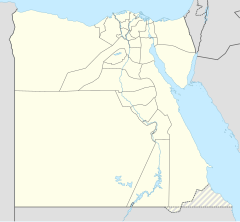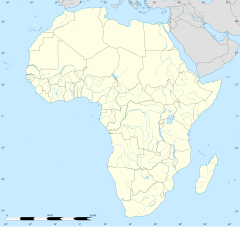Al-Sayeda Zainab Mosque (Arabic: مَسْجِد ٱلسَّيِّدَة زَيْنَب, romanized: Masjid As-Sayyidah Zaynab) is a historic mosque in Cairo, Egypt, and constitutes one of the most important and biggest mosques in the history of Egypt. The name is an honor to Sayyidah Zaynab bint Ali, one of the daughters of Ali, fourth Caliph and first Shi'ite Imam, and his first wife Fatimah, daughter of the Islamic prophet Muhammad.
| Al-Sayeda Zainab Mosque مَسْجِد ٱلسَّيِّدَة زَيْنَب | |
|---|---|
| Religion | |
| Affiliation | Sunni Islam |
| Region | North Africa |
| Status | Active |
| Location | |
| Location | Cairo, Egypt |
| Geographic coordinates | 30°1′54.2″N 31°14′31.49″E / 30.031722°N 31.2420806°E |
| Architecture | |
| Type | Mosque |
| Style | Islamic |
| Completed | ? 1547, 1768, 1940, 1969 (renovation) |
| Specifications | |
| Dome(s) | 1 |
| Minaret(s) | 1 |
Location
editThe mosque is located in Sayyidah Zainab District of Cairo, where its name was taken from the name of the mosque. The mosque occupies the center of the neighborhood and there is Al-Sayeda Zainab square in front of the mosque. The square is one of the most famous and important squares in Cairo, and there are numerous restaurants and cafes packed with people especially during the breakfast and sahur time of the Islamic month of Ramadan. Zayn al-Abidin Street connects the mosque to the different major locations in Cairo.
History
editThe mosque was considered built on top of the grave of Sayyida Zaynab the sister of Hasan and Husain. Some historians consider that Sayyida Zaynab was exiled to Egypt few months after the Battle of Karbala, where she settled for nine months before her death, and she was buried in this site.[1] As such, the location is considered one of the most notable places of Islamic history and the most popular tombs to visit among Sunnis and Isma'ili Shi'ites. However, many other people, primarily Twelver Shias, believe that Sayyida Zaynab was buried in Damascus, Syria, where the mosque of the same name is located today.
There is no accurate record of when the mosque was built over the grave of Sayyida Zaynab, and no historical references are currently available except for Ottoman Ali Pasha's order for renovation in 1547, and since then there were other renovations, including the one conducted by Amir Abdul Rahman in 1768 and the one in 1940 by the Ministry of Endowment which demolished the old building completely and built the current building. Henceforth, the mosque is not registered as an artifact of Islamic history. The mosque at the time consisted of seven corridors parallel to the wall of the qibla with a square dish covered with a dome. On the opposite side of the qibla wall is the mausoleum of Sayyida Zaynab, surrounded by a brass fence and topped by a tall dome. In 1969, the Ministry of Endowment doubled the area of the mosque.[2]
In 2022, the Egyptian authorities commenced maintenance and renovation efforts at the Al Sayeda Zainab Mosque,[3] culminating in a visit by President Abdel Fattah El-Sisi and Mufaddal Saifuddin on May 12, 2024, to mark its completion.[4]
See also
editReferences
edit- ^ "Balaghatun Nisa", by Abul Fazl Ahmad bin Abi Tahir
- ^ "حي السيدة زينب". Official Website of Cairo (in Arabic). Archived from the original on 2017-09-20. Retrieved July 20, 2017.
- ^ "Cairo to start renovation, maintenance work at historical Al Sayeda Zainab Mosque". Egypt Today. 12 April 2022.
- ^ "President Sisi inaugurates historic Sayyida Zaynab Mosque after renovation". Egypt Today. 12 May 2024.
External links
edit- Media related to Al-Sayeda Zainab Mosque at Wikimedia Commons


